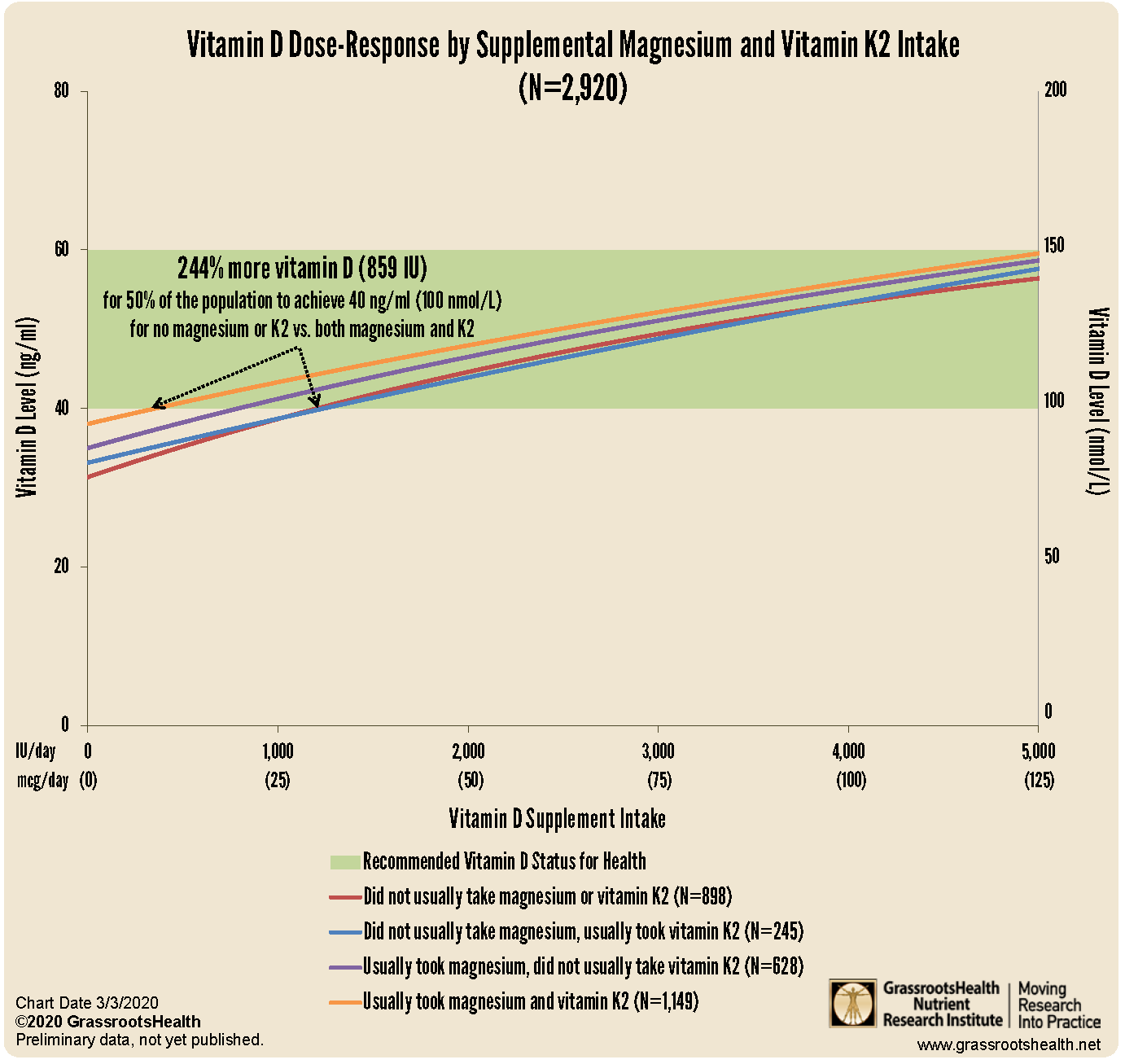Published on July 8, 2020
 If everyone were to get their vitamin D from adequate sun exposure, they would be more likely to have optimal levels. Unfortunately, our modern lifestyles do not allow for that. There are several factors that can influence how an individual’s vitamin D level responds to their supplementation and lifestyle habits (such as diet and sun exposure). It is because of these different factors between individuals that there is such a wide range of serum level responses that can be produced at any specific supplementation amount. For example, it is possible for a supplemental intake of 4000 IU/day to result in a serum level of 25 ng/ml (62.5 nmol/L) in one individual, and 60 ng/ml (150 nmol/L) in another. Testing vitamin D levels, versus blind supplementation, is therefore essential to know for sure if what you are taking is the right amount for you.
If everyone were to get their vitamin D from adequate sun exposure, they would be more likely to have optimal levels. Unfortunately, our modern lifestyles do not allow for that. There are several factors that can influence how an individual’s vitamin D level responds to their supplementation and lifestyle habits (such as diet and sun exposure). It is because of these different factors between individuals that there is such a wide range of serum level responses that can be produced at any specific supplementation amount. For example, it is possible for a supplemental intake of 4000 IU/day to result in a serum level of 25 ng/ml (62.5 nmol/L) in one individual, and 60 ng/ml (150 nmol/L) in another. Testing vitamin D levels, versus blind supplementation, is therefore essential to know for sure if what you are taking is the right amount for you.
Today we explore some of the factors that can contribute to the variability in response to vitamin D.
1. Vitamin D co-factors and competitors
In a previous blog we mentioned that a lack of key vitamin D co-nutrients can keep vitamin D levels from rising. What are co-nutrients and how are they important for vitamin D levels?
Co-nutrients are nutrients that work together for some process. If one co-nutrient is limited, either missing or not plentiful enough, then the process might also be limited. For example, your body needs magnesium to process and use vitamin D; without sufficient magnesium, the amount of vitamin D that can be metabolized by your body is limited.
An example can be seen in the chart below. Using the data provided for the GrassrootsHealth study from almost 3,000 participants with supplemental magnesium and vitamin K2 information, we plotted every participant’s supplemental vitamin D intake (dose) and blood level (response) and determined the average trends for participants who reported taking no supplemental magnesium or vitamin K2, those who reported usually taking both supplemental magnesium and vitamin K2, and those who reported taking only one or the other.
The dose-response chart above shows that on average, those taking both supplemental magnesium and vitamin K2 have a higher vitamin D level for any given vitamin D intake amount than those taking either supplemental magnesium or vitamin K2 or neither. Specifically, 244% more supplemental vitamin D was needed for 50% of the population to achieve 40 ng/ml (100 nmol/L) for those not taking supplemental magnesium or vitamin K2 compared to those who usually took both supplemental magnesium and vitamin K2.
A lack of other key vitamin D co-factors, such as boron and zinc, can reduce vitamin D absorption and production. On the other hand, a high intake of certain vitamins that compete with vitamin D, such as Vitamin A in the form of retinol or retinyl palmitate (not beta-carotene), can cause a reduction in vitamin D levels. This form of vitamin A is found in food from animal sources (especially liver) and some supplements. Also, some drugs including statins, prednisone and weight-loss drugs can block vitamin D.
2. Take your vitamin D supplement with a meal
Since vitamin D is a fat-soluble vitamin, taking it with a meal that contains fat can increase absorption. Also, adding a probiotic supplement can help with digestion in general and improve absorption of vitamin D.
3. Your lifestage impacts your ability to make vitamin D
With increased age comes a reduced ability to produce vitamin D in the skin in response to UVB exposure and a reduction in the kidney’s ability to convert vitamin D to its active form. Also, smokers and those with a high BMI tend to have lower levels.
4. Medical conditions can increase your use of and requirement for vitamin D
A recent illness or injury may result in a lower vitamin D level. Also, digestive conditions such as irritable bowel disease, Crohn’s disease, leaky gut, or celiac disease can limit the absorption of vitamin D in the gut. Those with diseases of the liver (e.g. fatty liver) or pancreas, who have had their gallbladder removed, or who have had bariatric surgery bypassing the small intestine are more likely to have trouble absorbing or metabolizing vitamin D. For these individuals, an increased dosage or other vitamin D metabolites may be needed (please consult with your physician if this is the case).
5. Dietary intake of vitamin D
Certain foods that have naturally occurring vitamin D (e.g. fish, meat, and eggs) or are fortified with vitamin D (e.g. milk and other dairy products, some orange juice and cereals) can impact vitamin D levels. Reduced consumption of these foods if they are normally in your diet may lower vitamin D levels. Additionally, some foods contain vitamin D2 (not D3) such as mushrooms that have been irradiated and some fortified foods (e.g. rice milk and soy milk) and while our body can use this form, it isn’t as effective as vitamin D3. Further, the amount of vitamin D available in food is rather small compared to what most people need to achieve a blood level of at least 40 ng/ml (e.g. salmon has ~450 IU/serving and fortified milk has ~120 IU/cup).
6. UVB exposure for vitamin D production
If you’re relying more heavily on sun exposure (or indoor UVB) for vitamin D, not exposing enough skin, high sunscreen use, or lack of mid-day (10 am – 2 pm) exposure will limit vitamin D production. Environmental factors such as smog and cloud cover or residing in a higher latitude will also reduce exposure to UVB radiation.
Additionally, the amount of melanin in the skin influences vitamin D production. Someone with more melanin (darker skin) might need 30 minutes in the sun to achieve the same production of vitamin D that someone with less melanin (lighter skin) will achieve in 10 minutes. While some people can achieve very high levels (~60 ng/ml or 150 nmol/L) of vitamin D through regular sun exposure alone, others cannot achieve these levels without supplemental vitamin D.
7. Time of sample collection
Vitamin D levels change naturally throughout the day, tending to be up to 20% higher mid-day than in the morning or evening, especially when taking a supplement. For those tracking their vitamin D levels over time, it is strongly recommended to collect your blood sample at the same time of day to have comparable results.
How is Your Body Responding to Vitamin D Supplementation?
If you have been consistently taking the same supplemental dose of vitamin D and experience a lower than expected vitamin D level, it’s possible that a change in diet, behavior, health, or the environment over the prior few months could have reduced your levels. Or, if you are having difficulty increasing your levels, try increasing your dose, taking it with your largest meal, and optimizing vitamin D co-factors to improve your levels. Testing and re-testing after making your adjustments is the only way to tell if what you are doing is helping you to achieve your target level of vitamin D! Test today.
Are You Getting Enough Vitamin D?
Do you know what your vitamin D level is? Be sure to test today to find out, and take steps to keep it within a target of 40-60 ng/ml or 100-150 nmol/L! Give your immune system the nutrients it needs to support a healthy you and protect yourself from unnecessary diseases.
Through GrassrootsHealth Nutrient Research Institute, you can also test your essential elements magnesium, copper, zinc and selenium, toxins such as lead, mercury and cadmium, as well as your omega-3 levels, inflammation levels and thyroid stimulating hormone (TSH) level. Find out your levels today! Log on to the test selection page (click the link below) to get your tests and see for yourself if your levels can be improved.
Make sure you track your results before and after, about every 6 months!
How can I track my nutrient intake and levels over time?
To help you track your supplement use and nutrient levels, GrassrootsHealth has created the Personal Health Nutrient Decision System called
For each specific supplement, you can track what days you take it, how much, and many other details. This will help you know your true supplemental intake and what patterns of use work for you to reach and maintain optimum nutrient levels. Check it out today!








